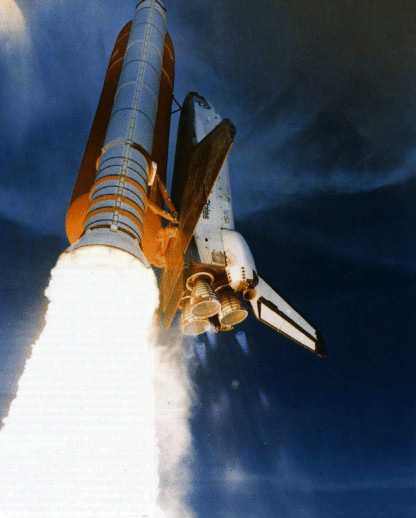Sci-fi Myths
Written: 1998.11.08
Last Revised: 2000.11.12
If you watch too much sci-fi, you become conditioned to its idiosyncrasies. One of those idiosyncrasies is that it's no big deal to lift off from a planet's surface and fly away into space. This feat is typically performed in mere minutes or even seconds in your average sci-fi film, and it's obviously no big deal, right?
Well, for civilizations that can fly across galaxies, it isn't a
big deal. But certain Trekkie fanatics can't stand to give even the
smallest concession to any other sci-fi series, even going so
far as to argue that the ships of SW, B5, Battlestar Galactica etc.
can't exceed 300 m/s or carry multi-megaton missiles. What they
don't realize is that the "simple" act of escaping a
gravity well conclusively disproves both of these claims, because
that "simple" act is a lot harder than they realize, for
the following reasons:
Gravitational potential energy: 1 kg has roughly -60 MJ of GPE on the surface of the Earth. Therefore, in order to escape gravity, a spacecraft must generate at least 60 MJ for every kg of its mass. To put this in perspective, TNT only releases 4.2 MJ/kg, which is why TNT doesn't blow itself into orbit when you set it off. Even the fallout released by nuclear weapons is blasted into the upper atmosphere, but eventually comes back down, even though it might take years. It is very difficult to push something into space, which is why real spacecraft are mostly composed of fuel, and must shed weight by discarding pieces as they go.
Power: If a ship can generate 60 MJ/kg, and its fuel tanks are a small percentage of its size, then its fuel must be good for much more than 60 MJ/kg of its fuel. The problem is that 60 MJ/kg is very high for chemical reactions, and it's inconceivable that any chemical fuel would ever exceed this by, say, an order of magnitude. Since most sci-fi ships' fuel tanks are unnoticeably small compared to their overall bulk, this means they must be using something much more powerful than chemical reactions, such as nuclear fusion. Even current plans for 21st century nuclear fusion reactors have a miniscule fraction of the power to weight ratio we're talking about, so these ships must have something far more advanced than any present-day schemes.
Velocity: Any spacecraft which can escape the gravity of a planet must be capable of velocities in excess of 11,000 m/s if it starts in space. Any spacecraft which can escape the gravity of a planet twice on one fuel load (such as Luke Skywalker's X-wing in TESB), must be capable of velocities in excess of 22,000 m/s. Continue this trend to your heart's content; the point is that it is impossible for a ship to be capable of escaping gravity without also being capable of speeds far in excess of the measly few hundred m/s attributed to every other sci-fi series by rabid Trekkies.
Acceleration: If a spacecraft can escape a planet's gravity well in a short time, we can estimate its acceleration. For example, if it can escape in less than one minute (like the escaping Rebel transports in TESB), it must accelerate at 15 to 20 g's. Any spacecraft which can escape so quickly must incorporate technology for making these deadly accelerations survivable, and engines capable of thrust 15 to 20 times as great as the ship's weight. To put this in perspective, if an F-15 Eagle had to escape our gravity well in less than a minute, it would need 700,000 to 900,000 pounds of thrust!
In short, even if we have no information about a ship besides the fact that it can repeatedly lift off from an Earth-like planet and fly into deep space without refuelling, we can conclude that it can easily exceed 11,000 m/s velocity. We can also conclude that its power generation is vastly more advanced than anything available to us. Therefore, derogatory Trekkie claims about other sci-fi series being limited to 300 m/s or sub-megaton missiles are obviously nonsense. Are we seriously supposed to believe they have less than 3% of the power required to escape gravity, or that they haven't yet discovered nuclear fusion?
Some Trekkies like to claim that Trek torpedoes are good for 64 megatons, and the missiles of SW or B5 can't come close. With the above information in mind, how reasonable does this sound to you? In fact, the Soviet Union actually built and then detonated a 50 megaton device named Tsar Bomba on October 30 1961. Perhaps more amazingly, it was a scaled-down prototype for a planned 100-150 megaton bomb! Obviously, there is no rhyme or reason to the claim that a 64 megaton photon torpedo warhead is beyond the reach of Star Wars, Babylon 5, Battlestar Galactica, Space: Above and Beyond, or any of those other dreaded sci-fi series that are guilty of the crime of not being Star Trek.
Acknowledgements
Kjetil Krokeide, for reminding me of the Russian "Tsar Bomba" weapon.